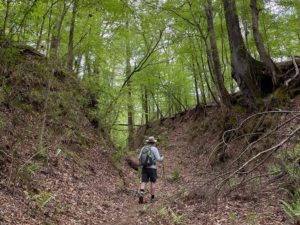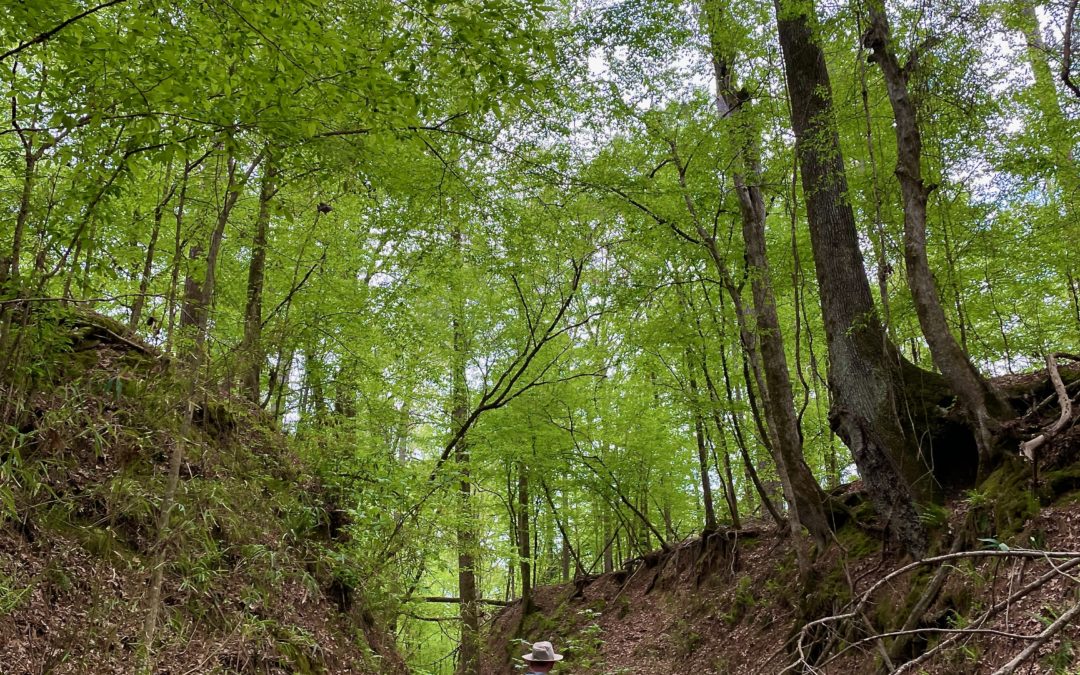
Meriwether Lewis died here. Aaron Burr did not, but two-and-a-half years after slaying Alexander Hamilton in a duel, he surrendered here. And thousands of Native Americans collectively left their mark when they trekked across this Southern locale during their forced resettlement march along the Trail of Tears.
Disclosure: This post contains affiliate links (among regular links) to products I own and like, or which I think you might like. This means that, at no extra cost to you, I will earn a commission if you click through and make a purchase.
This historic spot is the Natchez Trace, once the most important travel route in the Old Southwest. While only a smattering of the original path exists today, the 444-mile Natchez Trace Parkway preserves the trail and its rich history. The parkway, built between 1938 and 2005, follows the path of the original Trace, winding northeast from Natchez, Miss., to Nashville, Tenn.
More than six million people drive, cycle or hike along this undulating parkway every year, making it the National Park Service’s seventh most-visited site. They come partly for its picturesque and diverse landscape, which features bayous and swamps in the south and forestland, rocky outcrops and remnant prairies in the north. But they also come to learn its colorful history.
A Wealth of History Along the Natchez Trace
Dozens of interpretive sites dot the parkway, explaining the Old Trace’s past and showcasing notable remains, such as Gordon House, the 1818 red-brick home of the Gordons, who once ran a trading post and ferry. You can also see impressive Native American mounds, most notably Emerald Mound, a  35-foot-high earthwork and National Historic Landmark that’s the second-largest Mississippian Period ceremonial mound in the nation.
35-foot-high earthwork and National Historic Landmark that’s the second-largest Mississippian Period ceremonial mound in the nation.
A final bonus: 65 miles of hiking trail along the parkway are collectively designated the Natchez Trace National Scenic Trail, an elite classification shared by the famed Appalachian Trail and nine other standouts.
“The Natchez Trace can’t really be considered the region’s best-kept secret,” says Mandi Toy, the parkway’s acting chief of interpretation. “But people don’t really realize what’s all here until they stumble upon us.”
The Natchez Trace’s origins stretch back thousands of years, when prehistoric native peoples lived and traveled in the area. The pathways they trod became more firmly entrenched in the soil when the modern-day Natchez, Chickasaw and Choctaw nations settled here and added their footprints. Then, in the 1700s and early 1800s, after Europeans arrived and began moving westward, the footpath became an important highway of sorts, connecting the state of Tennessee with land that eventually became the Mississippi Territory.
Natchez Trace’s Heyday in Early 1800s
But the Trace’s heyday began in 1801, when President Thomas Jefferson ordered the U.S. Army to turn the rustic path into a federal road. The road development was ostensibly to allow mail delivery between Nashville and Natchez, and to provide safe passage home for the Kaintucks – boatmen who regularly sailed down the Mississippi to the port cities of Natchez and  New Orleans to sell their goods, then walked back home, the river being too difficult to navigate upstream. The improved road did help the post riders and Kaintucks, but it also served as a critical route for the movement of soldiers during the War of 1812 and other conflicts – possibly its intended purpose.
New Orleans to sell their goods, then walked back home, the river being too difficult to navigate upstream. The improved road did help the post riders and Kaintucks, but it also served as a critical route for the movement of soldiers during the War of 1812 and other conflicts – possibly its intended purpose.
From roughly 1800 to the mid-1830s, the Natchez Trace saw heavy traffic from soldiers, Kaintucks, animals, wagons and more. Stands, or inns, sprang up to serve the travelers, plus ferries, stores and other services. Yet a trip along the heavily used federal road was far from a pleasant stroll. “Hardships of journeying on the Old Trace included heat, mosquitoes, poor food, hard beds (if any), disease, swollen rivers, and sucking swamps,” reads one interpretive sign, noting “… a broken leg or arm could spell death for the lone traveler.”
Eventually, this critical-yet-challenging highway fell out of use when steamboats began plying the nation’s waterways. By the Civil War, no one thought twice about it. Then, new life. In 1938, the National Park Service took control of the land to save the final remnants of the Old Trace and build a parkway alongside them. This would ensure the Trace – and the stories of those whose lives depended upon it – would live on.
Spring or Fall Best Time to Visit Trace
Spring and fall are prime seasons to visit. The temperatures are moderate, and the landscape dazzles with colorful spring wildflowers or blazing fall foliage. Don’t plan a tight itinerary, as the parkway is designed to encourage  leisurely exploration. Commercial traffic is banned, and the roadway is free of billboards and traffic lights. All you have to do is enjoy the scenery and find the interpretive pullouts that match your interests: history, nature, Native American life and more.
leisurely exploration. Commercial traffic is banned, and the roadway is free of billboards and traffic lights. All you have to do is enjoy the scenery and find the interpretive pullouts that match your interests: history, nature, Native American life and more.
“The great thing about the parkway is that there really is something here for everyone,” Toy says.
While many of the interpretive spots make quick stops, consisting of explanatory signs and short trails, others are more in-depth. Rocky Springs, for example, used to be a thriving town of 2,600. Today you can explore its scattered remains, plus hike a section of both the Old Trace and the National Scenic Trail. At Mount Locust, a restored plantation and historic stand, there are house tours and exhibits.
Toy says one of the more popular stops is the Meriwether Lewis National Monument. Lewis is best known as the senior commander of the famous Lewis and Clark Expedition (1804-06) sent to find a commercial water route  to the Pacific Ocean. In 1809, Lewis left his home in St. Louis for Washington, D.C. to secure payment for some federal vouchers he’d submitted. His route led him along the Trace, where he mysteriously died of gunshot wounds while staying overnight at Grinder’s Stand. While historians largely agree he committed suicide, due to a history of depression and other issues, some believe a ne’er-do-well murdered him. In addition to Lewis’ grave and monument, the spacious site includes hiking paths, the remains of Grinder’s Stand and a campground.
to the Pacific Ocean. In 1809, Lewis left his home in St. Louis for Washington, D.C. to secure payment for some federal vouchers he’d submitted. His route led him along the Trace, where he mysteriously died of gunshot wounds while staying overnight at Grinder’s Stand. While historians largely agree he committed suicide, due to a history of depression and other issues, some believe a ne’er-do-well murdered him. In addition to Lewis’ grave and monument, the spacious site includes hiking paths, the remains of Grinder’s Stand and a campground.
Trace’s Potkopinu Section Rocks!
No matter your interests, make sure to check out the Potkopinu section of the National Scenic Trail. This three-mile path near Natchez features impressive pieces of what’s known as the Sunken Trace – areas filled with soft, loess soil that decades of constant traffic greatly compacted. In some spots, the trail here sunk as much as 20 feet below the surrounding terrain, exposing tangled tree roots overhead.
Although Potkopinu can be a challenging hike, try it anyway. For experiencing a slice of what the Kaintucks and other Trace-goers once faced may be the best history lesson of all.
If You Go
Plan to spend a night at the start or end of your trip in Natchez, Miss. Once home to half of the nation’s millionaires, due to its importance as a commercial hub, it features a wealth of stately antebellum homes, many of which today are inns.
If you complete the Natchez Trace in Nashville, it’s customary to grab a bite at the Loveless Cafe, which sits just off the parkway. The popular eatery dating to 1951 is famous for its fried chicken and biscuits.
Get your Natchez Trace Parkway guidebook here!




